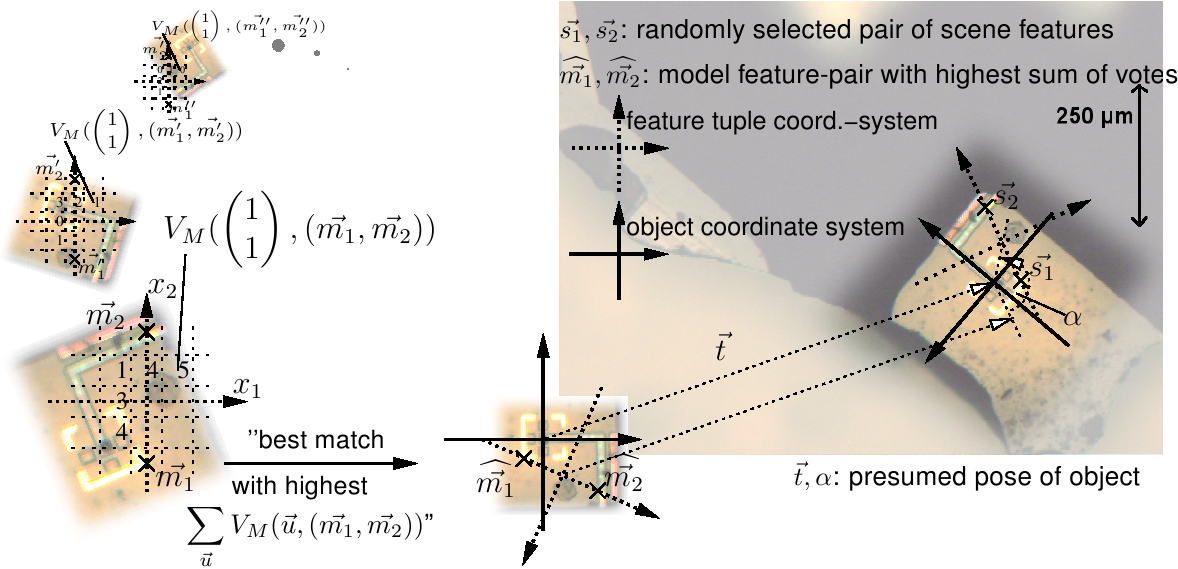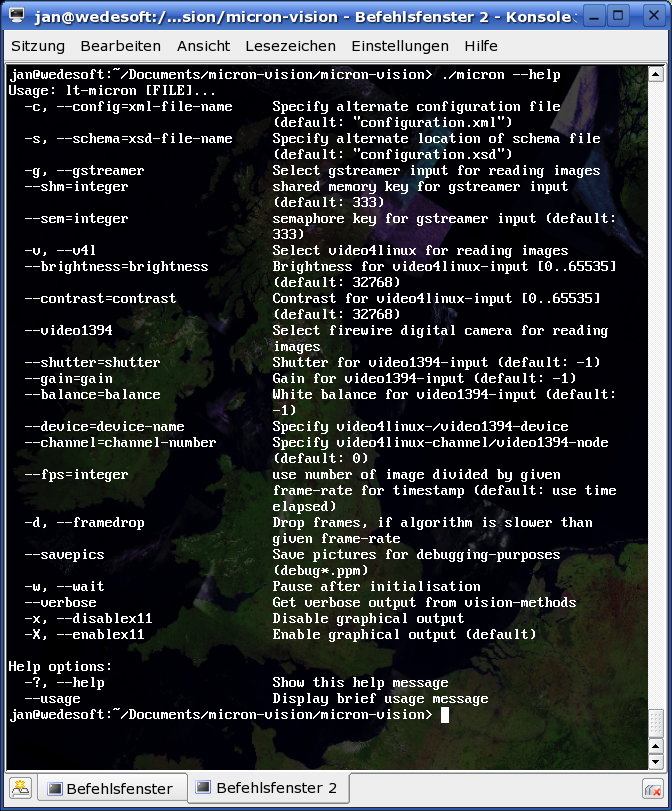Microscope Vision Software
m (→micron-vision-2.0) |
m |
||
| (37 intermediate revisions by 2 users not shown) | |||
| Line 1: | Line 1: | ||
| + | <html> | ||
| + | <div class="thumb tright"><div style="width:400px;"> | ||
| + | <object type="application/x-shockwave-flash" data="http://vision.eng.shu.ac.uk/jan/flv/flvplayer.swf" width="400" height="390"> | ||
| + | <param name="flashvars" | ||
| + | value="file=http://vision.eng.shu.ac.uk/jan/flv/micron.xml&shuffle=false&repeat=false&searchbar=false&displayheight=300" /> | ||
| + | <param name="movie" value="http://vision.eng.shu.ac.uk/jan/flv/flvplayer.swf" /> | ||
| + | <param name="allowfullscreen" value="true" /> | ||
| + | </object> | ||
| + | <div class="thumbcaption">The software can be configured for a variety of environments</div> | ||
| + | </div></div> | ||
| + | </html> | ||
=MiCRoN Microscope Vision Software= | =MiCRoN Microscope Vision Software= | ||
==Implementation== | ==Implementation== | ||
Computer vision for microscopes has to deal with the problem of limited depth of field. But instead of trying to overcome this, one can actually use the depth information concealed in this images to achieve real-time object recognition for microscopes. | Computer vision for microscopes has to deal with the problem of limited depth of field. But instead of trying to overcome this, one can actually use the depth information concealed in this images to achieve real-time object recognition for microscopes. | ||
| − | Employing | + | Employing '''sobel edge detection''', '''geometric hashing''' and the '''bounded hough transform''' it was possible to recognise two micro-objects in around 300 milliseconds allowing '''4 degrees of freedom''' and then '''track them''' in consecutive frames '''with rates of 15 frames per second'''! |
The software provides a '''framework''' to integrate and test different algorithms for recognition and tracking of multiple rigid objects. The parameters are stored in an XML file. The software offers a '''programmer's application interface''', which hides the inherent complexity (black-box principle), so that the '''vision-system''' can be integrated easily in a higher level system! | The software provides a '''framework''' to integrate and test different algorithms for recognition and tracking of multiple rigid objects. The parameters are stored in an XML file. The software offers a '''programmer's application interface''', which hides the inherent complexity (black-box principle), so that the '''vision-system''' can be integrated easily in a higher level system! | ||
==Results== | ==Results== | ||
| − | By using focus-stacks as models it was possible to provide '''real-time object recognition of multiple microscopic objects | + | By using focus-stacks as models it was possible to provide '''real-time object recognition of multiple microscopic objects in up to 4 degrees-of-freedom'''. The micro-objects are not required to stay at a fixed distance to the camera any more. Novel automated procedures in biology and micro-technology are thus conceivable. |
| − | '''Geometric hashing''' doesn't perform very well with increasing number of objects. | + | '''Geometric hashing''' doesn't perform very well with increasing number of objects. Currently '''RANdom SAmple Consensus''' (RANSAC) is being implemented and different types of features are being investigated. Due to real-time constraints the choice is limited however. The tracking algorithm based on the '''bounded hough transform''' on the other hand performed very well. |
| + | |||
| + | See [[MiCRoN Microscope Environment|sugar pushing demo]] for more results. | ||
{|align=center | {|align=center | ||
|- | |- | ||
| − | |[[Image:Test.png|200px|thumb|2-D/3 DOF real-time demo on graphical primitives (1.16 MByte [http://vision.eng.shu.ac.uk/jan/test.avi video])]]||[[Image:penguin.jpg|200px|thumb|2-D/3 DOF penguin live demo (999 kByte [http://vision.eng.shu.ac.uk/jan/penguin.avi video])]]||[[Image:Syringe3.jpg|thumb|200px|Object recognition and tracking of syringe chip in 3-D/4 DOF (16 MByte [http://vision.eng.shu.ac.uk/jan/syringe3.avi video])]] | + | |[[Image:Test.png|200px|thumb|2-D/3 DOF real-time demo on graphical primitives (1.16 MByte [http://vision.eng.shu.ac.uk/jan/test.avi video])]]||[[Image:penguin.jpg|200px|thumb|2-D/3 DOF penguin live demo (999 kByte [http://vision.eng.shu.ac.uk/jan/penguin.avi video])]]||[[Image:Syringe3.jpg|thumb|200px|Object recognition and tracking of syringe chip in 3-D/4 DOF (16 MByte [http://vision.eng.shu.ac.uk/jan/syringe3.avi video])]]||[[Image:Povray.jpg|200px|thumb|3-D/4 DOF time lapse video of demo on artificial images (1.53 MByte [http://vision.eng.shu.ac.uk/jan/povray.avi video])]] |
|- | |- | ||
| − | |[[Image: | + | |[[Image:Vision.jpg|150px|thumb|MiCRoN computer vision poster]]||[[Image:Gripper2.jpg|200px|thumb|Micro-gripper and capacitor with 4 resp. 3 degrees-of-freedom (2.78 MByte [http://vision.eng.shu.ac.uk/jan/gripper2.avi video])]]||[[Image:Edges.png|thumb|200px|Realtime edge detection (3.01 MByte [http://vision.eng.shu.ac.uk/jan/edges.avi video])]]||[[Image:Gripper.jpg|thumb|200px|Realtime object recognition and tracking with 3-D/4 DOF (859 kByte [http://vision.eng.shu.ac.uk/jan/gripper.avi video])]] |
| + | |- | ||
| + | |[[Image:Sphere.jpg|thumb|200px|Object recognition on a sphere with 3-D/3 DOF (922 kByte [http://vision.eng.shu.ac.uk/jan/sphere.avi video])]]||[[Image:Pipette.jpg|thumb|200px|Object recognition to locate intersection of pipette with focussed plane (2.25 MByte [http://vision.eng.shu.ac.uk/jan/pipette.avi video])]]||[[Image:SyringeGeometricHashing.png|thumb|200px|Illustration of Geometric Hashing with 3 degrees-of-freedom]]|| | ||
|- | |- | ||
|} | |} | ||
| Line 24: | Line 39: | ||
You can download the software (GPL license) and some test data to verify the results yourself! | You can download the software (GPL license) and some test data to verify the results yourself! | ||
===micron-vision-2.0=== | ===micron-vision-2.0=== | ||
| − | You first need to install the [http://vision.eng.shu.ac.uk/jan/mimas/ | + | You first need to install the [http://vision.eng.shu.ac.uk/jan/mimas/ latest unofficial release of Mimas-2.0] (28 MByte) of the [[Mimas|Mimas Real-Time Computer Vision Library]] to be able to compile and run [http://vision.eng.shu.ac.uk/jan/micron-vision/micron-vision-2.0.tar.bz2 micron-vision-2.0] (524 kByte). |
| + | ===Test Data=== | ||
The online documentation is [http://vision.eng.shu.ac.uk/jan/micron-vision-docs/ here] and you may also want to download some test data | The online documentation is [http://vision.eng.shu.ac.uk/jan/micron-vision-docs/ here] and you may also want to download some test data | ||
* [http://vision.eng.shu.ac.uk/jan/micron-vision/test.tar.bz2 Data for test ''test''] (1.67 MByte) | * [http://vision.eng.shu.ac.uk/jan/micron-vision/test.tar.bz2 Data for test ''test''] (1.67 MByte) | ||
| Line 33: | Line 49: | ||
=See Also= | =See Also= | ||
| − | * | + | * [[Microscope Control Software]] |
| − | * | + | * [[Microscope Environment]] |
| + | * [[Depth from Focus]] | ||
| + | * [[TEM vision software]] | ||
| + | * [[Image:mimasanim.gif|48px]] [[Mimas]] | ||
| + | * [[Image:Hornetseye.png|48px]] [[Hornetseye]] | ||
=External Links= | =External Links= | ||
* [http://vision.eng.shu.ac.uk/jan/micron-vision-docs/ Online documentation] of MiCRoN Microscope Vision Software | * [http://vision.eng.shu.ac.uk/jan/micron-vision-docs/ Online documentation] of MiCRoN Microscope Vision Software | ||
| + | * J. Wedekind, M. Boissenin, B.P. Amavasai, F. Caparrelli, J. Travis: [http://vision.eng.shu.ac.uk/jan/IMVIP_wedekind_CR.pdf Object Recognition and Real-Time Tracking in Microscope Imaging] (also see [http://elm.eeng.dcu.ie/imvip/proceedings.html IMVIP 2006 proceedings]) | ||
| + | * N. Leibowitz, Z.Y. Fligelman, R. Nussinov, H.J. Wolfson: [http://www.math.tau.ac.il/~wolfson/papers/ismb99.ps.gz Multiple Structural Alignment and Core Detection by Geometric Hashing] | ||
| + | * M. A. Greenspan, L. Shang, P. Jasiobedzki: [http://rcvlab.ece.queensu.ca/~greensm/papers/GreShaJas04.pdf Efficient Tracking with the Bounded Hough Transform] | ||
| + | |||
| + | {{Addthis}} | ||
| + | [[Category:Projects]] | ||
[[Category:Micron]] | [[Category:Micron]] | ||
Latest revision as of 15:50, 26 May 2010
Contents |
[edit] MiCRoN Microscope Vision Software
[edit] Implementation
Computer vision for microscopes has to deal with the problem of limited depth of field. But instead of trying to overcome this, one can actually use the depth information concealed in this images to achieve real-time object recognition for microscopes.
Employing sobel edge detection, geometric hashing and the bounded hough transform it was possible to recognise two micro-objects in around 300 milliseconds allowing 4 degrees of freedom and then track them in consecutive frames with rates of 15 frames per second!
The software provides a framework to integrate and test different algorithms for recognition and tracking of multiple rigid objects. The parameters are stored in an XML file. The software offers a programmer's application interface, which hides the inherent complexity (black-box principle), so that the vision-system can be integrated easily in a higher level system!
[edit] Results
By using focus-stacks as models it was possible to provide real-time object recognition of multiple microscopic objects in up to 4 degrees-of-freedom. The micro-objects are not required to stay at a fixed distance to the camera any more. Novel automated procedures in biology and micro-technology are thus conceivable.
Geometric hashing doesn't perform very well with increasing number of objects. Currently RANdom SAmple Consensus (RANSAC) is being implemented and different types of features are being investigated. Due to real-time constraints the choice is limited however. The tracking algorithm based on the bounded hough transform on the other hand performed very well.
See sugar pushing demo for more results.
 2-D/3 DOF real-time demo on graphical primitives (1.16 MByte video) |
 2-D/3 DOF penguin live demo (999 kByte video) |
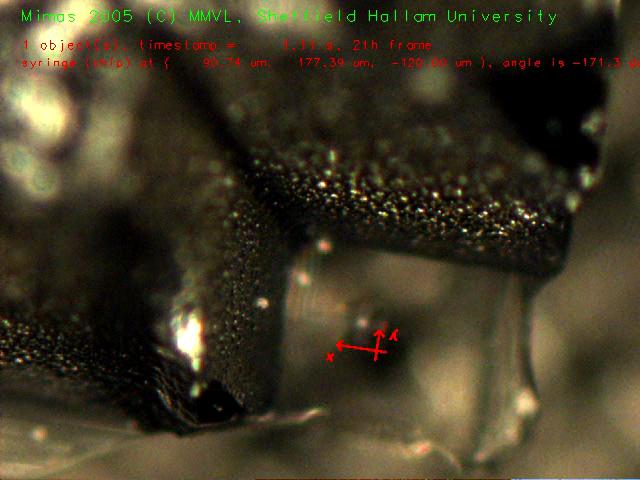 Object recognition and tracking of syringe chip in 3-D/4 DOF (16 MByte video) |
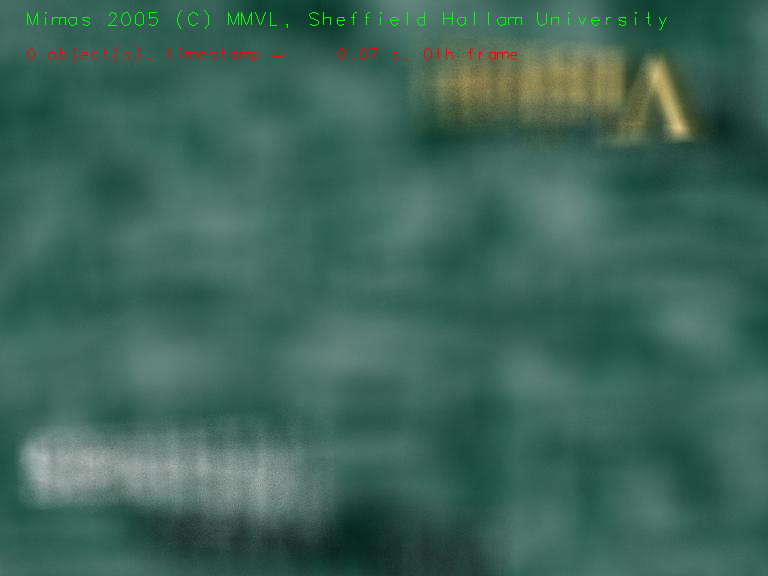 3-D/4 DOF time lapse video of demo on artificial images (1.53 MByte video) |
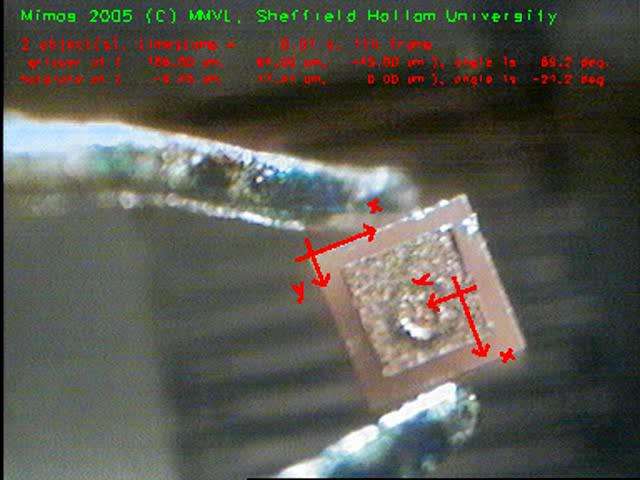 Micro-gripper and capacitor with 4 resp. 3 degrees-of-freedom (2.78 MByte video) |
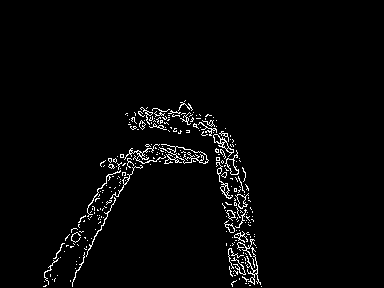 Realtime edge detection (3.01 MByte video) |
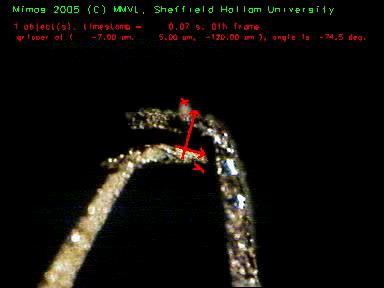 Realtime object recognition and tracking with 3-D/4 DOF (859 kByte video) | |
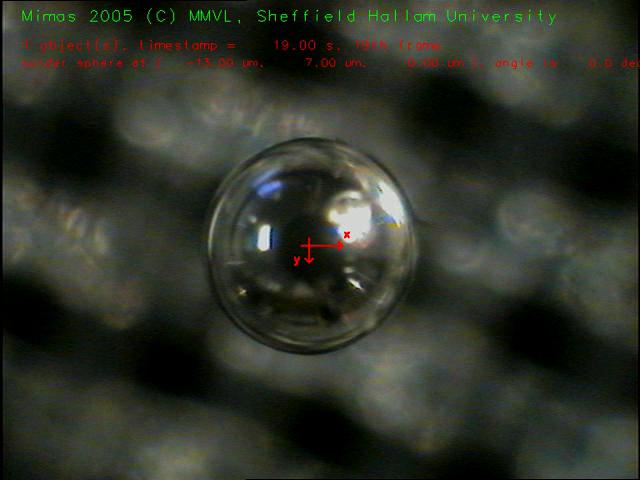 Object recognition on a sphere with 3-D/3 DOF (922 kByte video) |
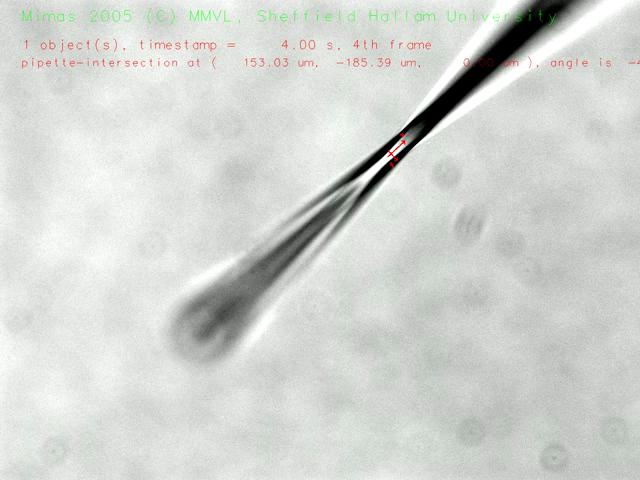 Object recognition to locate intersection of pipette with focussed plane (2.25 MByte video) |
[edit] Download
You can download the software (GPL license) and some test data to verify the results yourself!
[edit] micron-vision-2.0
You first need to install the latest unofficial release of Mimas-2.0 (28 MByte) of the Mimas Real-Time Computer Vision Library to be able to compile and run micron-vision-2.0 (524 kByte).
[edit] Test Data
The online documentation is here and you may also want to download some test data
- Data for test test (1.67 MByte)
- Data for test test2 (1.08 MByte)
- Data for test povray (5.08 MByte)
- Data for test sphere (8.65 MByte)
[edit] See Also
- Microscope Control Software
- Microscope Environment
- Depth from Focus
- TEM vision software
-
 Mimas
Mimas
-
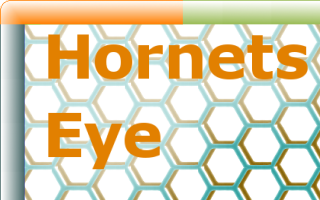 Hornetseye
Hornetseye
[edit] External Links
- Online documentation of MiCRoN Microscope Vision Software
- J. Wedekind, M. Boissenin, B.P. Amavasai, F. Caparrelli, J. Travis: Object Recognition and Real-Time Tracking in Microscope Imaging (also see IMVIP 2006 proceedings)
- N. Leibowitz, Z.Y. Fligelman, R. Nussinov, H.J. Wolfson: Multiple Structural Alignment and Core Detection by Geometric Hashing
- M. A. Greenspan, L. Shang, P. Jasiobedzki: Efficient Tracking with the Bounded Hough Transform

